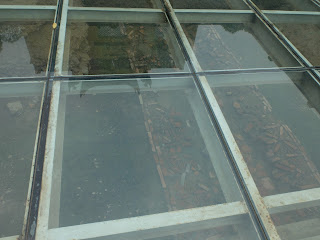After returning from my whirlwind romp around Cambodia and Thailand I needed to get back to work and earn that bacon- the only way to keep travelling is to keep working, fair is fair. But I still managed to fit in some more day trips/fun events around Hanoi during Autumn. Thang Long Citadel was one of the first places I visited when I got back. (The citadel is not attached to the tower that many people see in pictures of Hanoi, which is actually attached to the Vietnam Military History Museum on the other side of the block. You can't access them at the same time, they're separate museums.) Both are located centrally in Hanoi, across Điện Biên Phủ Street from the large triangular park where you can find the large Lenin statue and in the early mornings, throngs of senior citizens doing aerobics, dancing and playing badminton. It's a pretty cool park, actually. On the weekends it is mobbed with families just out and about, letting their kids play with the small motorized cars and each other. There are always people exercising and tourists wandering about confusedly.
So the actual citadel has a long and interesting militaristic and cultural history going back to the middle ages. It was at one point, if I am remembering this correctly, essentially a city/palace/military complex all in one.
Hanoi has not always been the capital of Vietnam, nor has it always been named Hanoi. Before it has been: Long Biên, Tống Bình (Song Peace), Long Đỗ (Dragonbelly), Đại La (Big Net), Đông Kinh (Eastern Capital, also where we get the word "Tonkin), Đông Đô (Western Capital, after the actual capital was moved), and Thăng Long (Soaring Dragon, similar to how Hạ Long [Bay] is Descending Dragon). This is not a young city and I think its ability to remain an entity, while growing and changing in character, for several thousand years attests to its resilience. Anyway, Thang Long was one of the last names that was used before it was changed to Hà Nội (Between Rivers) in the early 19th century and which it has been ever since.
Most of what you can see in this picture is reconstruction as the citadel fell into disrepair in the last few centuries and was mostly destroyed during French/American occupation (although also used as a military post by both at various times). Only has in the last decade or so started being really excavated.
Bonsai tree park in front of the citadel.
View of said flag tower from the citadel remains.
Current excavations of the old city underneath.
Old-ass gong.
Behind the citadel are several buildings worth of museum devoted to what has been found in the recent excavations.
Roof pieces.
More cool roof pieces.
For traditional getting sloshed purposes.
THESE ARE ALSO ROOF TILES. What? Yes.
There's an infographic below with details but the gist is this: in Vietnam, the turtle is sacred. "Nough said.
Famous dragon steps. You are NOT allowed to walk on/touch these.
Remnants of the American War. Unfortunately this was not open when I visited.
Traditional alter inside one of the buildings in the citadel complex.
Thanks for all the dragons, citadel! An interesting history that will hopefully yield more information about ancient Hanoi as they continue to excavate. There were actually roped off areas when I was visiting where they were clearly still digging. Besides the interest of the museums and architecture, the grounds of this site are also lovely. Lots of plants and flowers and trees which are often helpfully labeled in English, Latin, and Vietnamese. Pretty cool part of Hanoi.



































Chuseok Korean Holiday is a time to enjoy traditional Korean food and games.
ReplyDelete